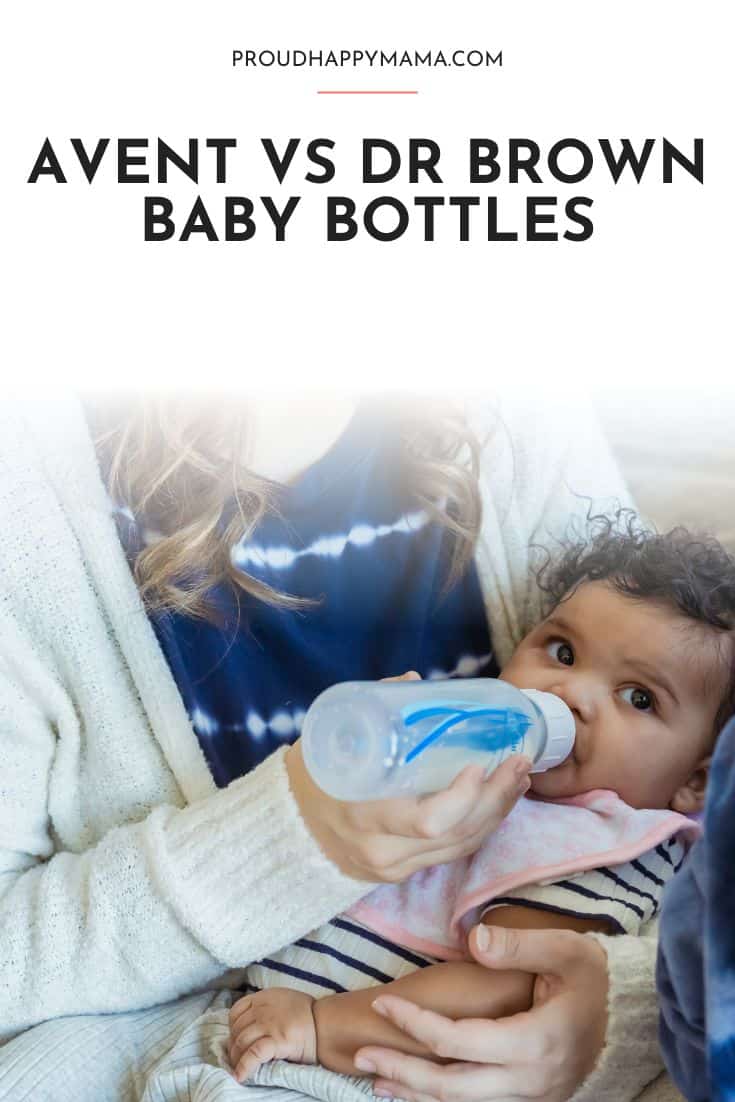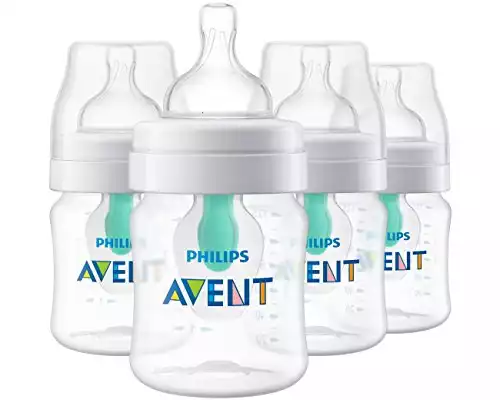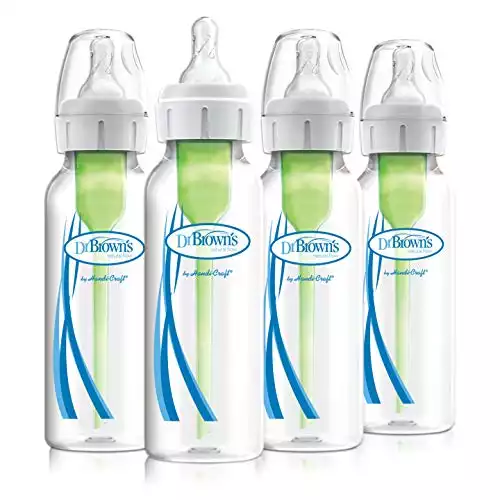Avent Vs Dr Brown
Are you trying to decide between Avent vs Dr Brown bottles to help make feeding time easier for you and your baby?
Then let us help you find the best anti-colic bottles suited to your baby’s needs with our guide on Dr Brown bottles vs Avent!
Choosing a bottle for a baby seems like it should be as easy as picking out tableware, but this is a surprisingly tricky task. There’s a lot to consider when choosing a bottle, from the size, to the nipple, to the material.
Philips Avent and Dr. Brown’s both make bottles designed to improve feeding by reducing air in the bottle. Excess air can lead to painful digestion, spit-up, and gas. By venting the bottles, your little one gets more milk, and less air!
But which brand is right for you? In this guide, we’ve taken a look at both Avent and Dr. Brown’s anti-colic bottles, to see how they compare including their features, pros, and cons.
And if you love this guide on Dr Brown vs Avent anti colic bottles, make sure you check out these guides on best bottles for breastfed babies, how many baby bottles do I need, and do baby bottles expire. Or even our guide on the best baby bottles for reflux!
This post contains affiliate links. See our full disclosure here

Avent Vs Dr Brown
We’ll begin by taking a closer look at both Avent and Dr. Brown’s.
All About Avent Anti Colic Bottles
Philips Avent anti-colic bottles have been designed with a unique AirFree vent, to reduce colic symptoms but keeping gas out of milk or formula.
The AirFree vent works by funneling air away, and trapping milk in the nipple. With each gulp, your baby swallows more milk, and less air. Even when the bottle is held horizontally, the nipple stays full of milk. This allows you to feed your baby in an upright position, which can ease digestive issues.
Fitted with an anti-colic nipple, the Avent bottle encourages a secure latch with no collapsing. The bottle should feel natural to use, and the various flow levels allow your little one to feed naturally.
The Avent bottles achieve their anti-colic design with minimal parts, making this an easier bottle to clean. However, some parents are less impressed with the anti-colic features than those of similarly priced bottles.
Pros
- The Air-Free vent channels air away from the milk, for less gas and more comfortable digestion.
- The nipple stays full even when the bottle is horizontal, so you can feed in an upright position.
- With only a few parts, the Avent anti-colic bottle is easy to clean.
- The shaped nipple encourages a secure latch with no collapsing.
- Minimal leaks, so a great bottle to use on the go.
Cons
- Some find that even the slowest flowing nipple is a little fast.
- The AirFree vent isn’t quite as effective as other, similarly priced designs.
All About Dr Brown Anti Colic Bottles
Dr. Brown’s anti-colic bottles are the number one pediatrician recommended baby bottle in the US, and they’re a favorite among many parents. Dr. Brown’s anti-colic bottles have been clinically proven to reduce colic symptoms, using an innovative internal vent system.
Dr. Brown’s bottles use vacuum-free feeding to create an experience as close to breastfeeding as possible. An internal vent system channels the air away from milk and formula, so babies swallow less gas with each gulp. By keeping the air away from the milk, these bottles also help preserve the nutrients inside!
To mimic the breastfeeding experience, Dr. Brown’s anti-colic bottles provide a consistent flow, and the nipples are available in numerous flow rates. But watch out for spills! Some parents have found these bottles have a tendency to leak.
Pros
- The internal vent has been clinically proven to reduce colic symptoms by channeling air away from milk.
- The only bottles that best preserves nutrients in both breast milk and formula.
- Can be used with nipples in many different flow rates, for consistent and comfortable feeding.
- Both glass and BPA-free plastic designs are available.
- A shaped nipple that closely mimics a breast for more natural feeding.
Cons
- Parents have found that Dr. Brown’s anti-colic bottles have a tendency to leak.
- With multiple parts in every bottle, cleaning can be tricky.
Similarities And Differences Between dr browns bottles vs avent anti colic
Dr. Brown’s and Philips Avent bottles are both hugely popular with parents, particularly those who have experience with colic. Both brands use a vented design to try and ease digestion, for happier feeds. But how do the bottles compare to each other?
In this section, we’ll explore the similarities and differences between Avent and Dr. Brown’s anti-colic bottles.
Anti-Colic
Swallowing too much air is thought to be one of the causes of colic, as a build up of gas in the tummy feels uncomfortable, and even painful. Both Dr. Brown’s bottles and Avent bottles are designed to ease colic symptoms by reducing the amount of air in each gulp.
Dr. Brown’s bottles are built with an internal vent system, which channels the air away from the milk. When the bottle is tipped, the vent ensures only milk makes its way to the nipple. The milk can come through consistently, in a flow that mimics breastfeeding. Feeding is more comfortable, and gas, spit-up, and burping is reduced.
Avent baby bottles work using a similar system, designed to reduce the amount of air in each gulp. The AirFree vent draws the air away, and keeps the nipple full of milk. And as the nipple is full even when horizontal, you can use the bottle when your baby is upright. This can help reduce reflux, and aids digestion.
The big question here is: which system is better? Overall, parents seem to find Dr. Brown’s more effective at reducing colic. But with that said, the Avent isn’t far behind.
Nipples
Alongside the internal venting, both Dr. Brown’s and Avent use clever nipple designs to help reduce colic.
The Avent anti-colic nipple is built with an integrated valve, to channel the air away from the milk, and away from your baby’s stomach. The nipple is shaped and ribbed to ensure a secure latch, and to prevent collapsing from interrupting the feeding. The Avent anti-colic nipple is available with four different flow rates. However, some find that even the slowest flow can be a little fast.
Dr. Brown’s nipple is designed to mimic the breast, to encourage secure latching and an even flow. The main advantage of Dr. Brown’s nipples is the variety of flow rates. With more to choose from, it’s easier to find a flow that’s just right for your baby, regardless of age.
Cleaning
Cleaning a baby bottle is never very fun, but it’s something that needs to be done! If you pick the Phillips Avent anti-colic bottles, you’ll find cleaning quick and easy. With just a few parts and a wide neck, you can flush out all the corners, for a clean bottle in no time at all.
Dr. Brown’s anti-colic bottles, on the other hand, are hard work to get clean. That excellent venting system requires several pieces to work properly, and it can be fiddly to get every section completely clean.
Leaking
Dr. Brown’s bottles do have a slight reputation for leaking, with some parents finding even a quick trip out can end in spilled milk. Careful sealing and balancing can negate this problem, but when you’re looking after a baby, you don’t always have the time or energy to delicately balance a bottle in a bag.
Leaking is a risk with any baby bottle, and some parents have had issues with the Philips Avent. However, it appears to be a much bigger problem with Dr. Brown’s.
Materials And Sizing Options
Dr. Brown’s anti-colic narrow bottles are sold in sizes 8 oz and 4 oz, and the wide-neck anti-colic bottles are sold in sizes 9 oz and 5 oz.
Philips Avent anti-colic bottles are sold in sizes 9 oz and 4 oz (with AirFree vent), and in sizes 11 oz and 4 oz (without the AirFree vent).
Both Avent and Dr. Brown’s bottles are made from BPA plastic, which is safe to use around newborns. Dr. Brown’s anti-colic bottles are also available in glass. Avent bottles are plastic only. Glass is generally considered easier to clean, but it is more prone to damage.
Nutrient Preservation
An added bonus of Dr. Brown’s internal vent is that it helps preserve the nutrients in breast milk and formula. It does this by preventing air from reaching the milk, as air can cause the nutrients to deteriorate. Untouched inside the bottle, these nutrients then go straight into your little one, where they can get to work!
Dr. Brown’s claims to be the only bottle that preserves nutrients, so this is definitely a plus.
However, using the Philips Avent bottles won’t prevent your baby from getting the nutrients they need!
Final Thoughts On Dr Brown bottles vs Avent
Colic can be a nightmare to deal with, causing a lot of stress for both parents and babies. Both Dr. Brown’s and Avent anti-colic bottles do help to reduce colic symptoms, by limiting the intake of air when feeding.
Overall, Dr. Brown’s offers the best anti-colic performance. The exceptional funneling system is hugely popular, and for very good reason — it works!
However, as an overall bottle, Avent anti-colic comes out on top. It’s easier to clean, and less prone to leaks. The anti-colic system is decent, just not quite at the standard of Dr Brown.
We hope this guide has helped you understand Avent and Dr. Brown’s bottles, so you can find the right option for you.
And if you’re looking for more great guides, make sure to check out these guides on best bottles for tongue tie, how to warm bottles on the go and can you reuse breast milk storage bags.



